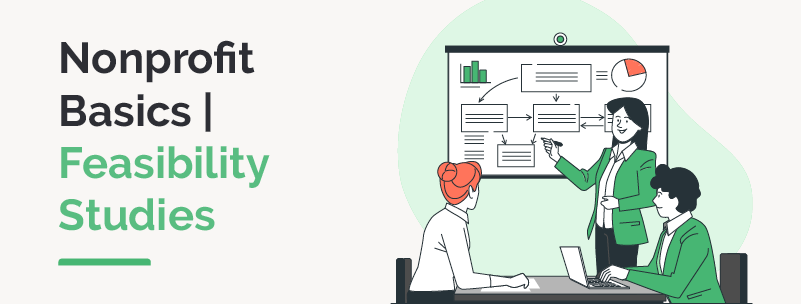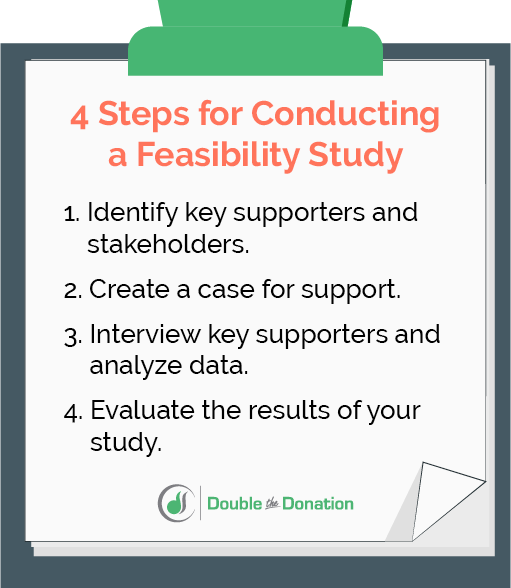Nonprofit Basics: An Overview of Feasibility Studies
In order to lead a successful fundraising campaign, your nonprofit has to put a lot of time and effort into planning it. From working to understand your donors to investing in the right fundraising tools and launching a robust marketing strategy, there are a lot of moving parts to manage.
But these tasks become especially critical (and complex) when it comes to planning large-scale campaigns, like capital campaigns.
In order to make sure that a capital campaign is truly a viable project for your nonprofit and that you’re setting achievable goals, you should conduct a thorough feasibility study. These studies can be complex, so we’re here to help you get up to speed on the basics. Let’s go!
What Is a Feasibility Study?
A feasibility study helps your nonprofit assess its current capacity and readiness for conducting a large-scale campaign, like a capital campaign.
The study tests your preliminary plans and goals by gathering input from the stakeholders who will later help make the campaign a reality, including board members, major donors, and other funders and partners in the community.
Nonprofits typically conduct a capital campaign if they’re building or expanding a facility, investing in an endowment fund, or purchasing equipment or supplies. Because of the size of these projects, they can take multiple years to complete, which is why it’s so critical to know whether your nonprofit is ready to launch a campaign at the desired scale long before you begin investing heavily in planning it.
4 Steps to Conducting a Fundraising Feasibility Study
To get a complete picture of your organization’s current ability to conduct your large-scale campaign, you’ll need to conduct a thorough feasibility study. Here are the four major steps you’ll need to take to conduct your study:
1. Identify key supporters and stakeholders.
Without a good number of supporters to back your campaign, you’ll struggle to meet your goal. That’s why the first step of conducting a fundraising feasibility study is to identify your key supporters and stakeholders.
Of course, you likely already have some supporters that come to mind, like your board members, long-time major donors, community stakeholders, and local business owners. Learn more about them by conducting prospect research.
Prospect research is the process of identifying new potential donors (or, at this stage, getting to know existing supporters) who have both the capacity (wealth) to give large gifts and an affinity (warmth) for your cause. Prospecting will involve leveraging your current donor database, prospect generator tools, government records, and more to learn about your supporters.
Once you’ve identified a prospect you think would likely want to back your project, it’s time to start getting to know them. Take your time identifying your key supporters—building a genuine relationship with a prospect is far more valuable than scurrying to secure a one-time donation.
2. Create a case for support.
The next step in a feasibility study is to draft up a case for support (also known as a case statement). This document explains the purpose of your campaign and gives compelling reasons why your supporters should help you with your campaign.
You should include the following in your case for support:
- Overview of your organization’s mission, story, and larger goals
- An explanation of why the project is needed
- Projected costs and a timeline
- Reasons your supporters should help fund the project
Once you’ve created a compelling case for support, you can use it in the interview phase of the feasibility study to gather feedback on your campaign from your key supporters.
3. Interview your key supporters and analyze your data.
During this step of the study, you find out how your supporters feel about your campaign and how viable your project actually is given your organization’s current capacity.
For the interview portion of the study, you should prepare thoughtful interview questions that help you better understand why your key supporters back your organization and what they think about your project. Many nonprofits have a fundraising consultant conduct these interviews so that they can obtain objective information from their key supporters.
For the data analysis process, you’ll take a critical look at the results of your interviews, your donor data, and the information you’ve gathered from prospecting.
4. Evaluate the results of your study.
Once you have all of the information from your feasibility study compiled, it’s time to evaluate the results. Typically your results will point to four options:
- Move forward with the campaign.
- Adjust your working fundraising goal up or down depending on the results.
- Adjust the timeframe of the campaign to allow for a longer donor cultivation process.
- Hold off on conducting the campaign.
If your organization is ready to move forward, it’s time to make any necessary adjustments to your campaign plan and present it to your organization’s leaders.
However, learning that your nonprofit isn’t quite ready for a large-scale campaign can be a tough pill to swallow, especially after investing time and effort into a thorough feasibility study. But you can use the feedback and data you’ve gathered to begin refining your organization’s strategies and planning for a bright future.
Working With a Fundraising Consultant: The Key to a Comprehensive Feasibility Study
Many nonprofit organizations find it helpful to call in the help of a third-party expert—a nonprofit fundraising consultant—when conducting a feasibility study. While these professionals will be invested in your organization’s unique goals, they can also help you take an objective approach to the feasibility study and set you up with the fresh strategies your need to succeed with your campaign.
Specifically, they can help with the following:
- Conducting thorough prospect research
- Facilitating objective interviews with key supporters
- Assisting your organization with data analysis and interpreting the results of your study
- Helping your nonprofit determine the next steps after a feasibility study
Feasibility studies are an important part of preparing your organization to dive into a large-scale campaign. Make sure to allow yourself plenty of time to collect all the information you need to evaluate your organization’s capacity and to lean on the help of outside experts as you conduct your own study!
Other Resources to Explore
Nonprofit Basics – Learn more nonprofit management essentials by exploring other expert resources.
Creating a Fundraising Strategy: 12 Steps for Your Nonprofit – Looking to streamline your entire fundraising strategy? This guide can help!
Choosing the Right Prospect Research Consultant: 5 Factors – Prospect research helps you learn more about potential donors in your community. In this article, you’ll learn what you need to consider when hiring a consultant to assist you with prospecting.



